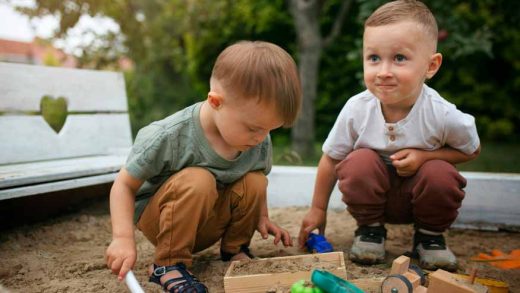Welcoming a baby into your home is a delightful and transformative experience, and for many parents, sharing a room with their newborn is a natural choice. Creating a harmonious sleep environment requires thoughtful consideration, ensuring both the baby and parents can rest peacefully. In this blog, we are going to explore some tips for sharing a room with a baby and essential baby care equipment.
Tips For Sharing Room With Baby
When parents share a room with a toddler and baby can follow these tips to have a peaceful environment.
- Cozy Sleep Space
- Optimal Room Temperature
- Strategic Furniture Placement
- Soft Lighting
- Blackout Curtains
- White Noise Machine
- Comfortable Feeding Station
- Portable Changing Station
- Easy Access to Essentials
- Safe Sleep Practices
- Consistent Sleep Routine
- Regular Sleep Assessments
- Breathable Sleepwear
- Accessible Storage Solutions
- Personalized Sleep Space
- Safety Measures
- Consistent Sleep Schedule
- Monitor Sleep Cues
- Routine Sleep Assessments
- Adequate Swaddle Technique
- Calming Scents
- Gentle Sleep Interventions
- Establish Feeding Routines
- Transition to Own Sleep Space
Create a cozy and designated sleep space for your baby within the room. Use soft bedding, a comfortable crib or bassinet, and ensure adequate ventilation.
Maintain a comfortable room temperature, typically between 68-72°F (20-22°C), to promote restful sleep for your baby.
The main tips for sharing a room with a baby are to arrange furniture to optimize space and provide easy access to your baby’s sleep area. Ensure a clear path for nighttime caregiving.
Implement soft, adjustable lighting for nighttime caregiving without disturbing the overall sleep environment.
Install blackout curtains to create a dark and calming atmosphere conducive to restful sleep.
Utilize a white noise machine to drown out ambient sounds and create a soothing background for your baby.
If breastfeeding, set up a comfortable feeding station with a supportive chair, side table, and soft lighting.
Designate a portable changing station with all necessary supplies for convenient and efficient nighttime changes.
When parents share a room with their baby, organize essential things, such as diapers, wipes, and clothing, within easy reach for quick and quiet access during the night.
Adhere to safe sleep practices, placing your baby on their back in a crib or bassinet with no loose bedding or toys.
Establish a consistent sleep routine to signal bedtime, incorporating calming activities like a warm bath or lullabies.
Regularly assess your baby’s sleep environment and routine, making adjustments based on their changing needs and developmental stages.
Dress your baby in breathable and comfortable sleepwear appropriate for the room temperature.
Use accessible storage solutions like baskets or bins to keep the room organized and clutter-free.
Add personal touches to your baby’s sleep space, such as framed photos or a soft mobile, creating a familiar and comforting environment.
When parents share a room with a toddler and baby ensure the room is baby-proofed with secure furniture, covered electrical outlets, and a safe sleep environment.
Maintain a consistent sleep schedule for both daytime naps and night time sleep to regulate your baby’s internal clock.
Pay attention to your baby’s sleep cues, such as eye rubbing or fussiness, for timely and responsive sleep interventions.
Conduct routine assessments of your baby’s sleep patterns, adjusting the sleep environment and routine as needed.
If your baby enjoys being swaddled, learn and practice proper swaddling techniques for a secure and comfortable sleep.
Introduce calming scents, such as lavender, to create a relaxing atmosphere conducive to sleep.
If your baby is restless, use gentle interventions like softly patting their back or offering a pacifier to soothe them back to sleep.
Ensure your baby is getting adequate nutrition during feedings, as hunger can disrupt sleep.
Plan a gradual transition to your baby’s own sleep space when they are developmentally ready, considering factors like age and sleep patterns.
Where Should The Baby Sleep in The Parents Room?
The baby should ideally sleep in a designated area near the parents’ bed. This can be in a crib, co-sleeper, or bassinet, ensuring easy access for night time care while maintaining a safe sleep environment.
How Long Can A Baby Share A Room With Parents?
The AAP recommends room-sharing for at least the first six months, and ideally up to one year. Extended room-sharing has been associated with a reduced risk of SIDS, allowing parents to monitor their baby closely while providing comfort and reassurance. However, as your baby grows and sleep patterns evolve, it’s essential to assess when they may be ready for their own sleep space.
Baby Care Equipment
- Baby Monitor with Video Capability:
- Diaper Changing Station:
- Nursing Station:
- Storage Solutions:
- Portable Bassinet or Co-Sleeper:
- Compact Diaper Pail:
Choose a reliable baby monitor with video capability for peace of mind and easy monitoring.
Set up a designated diaper changing station with diapers, wipes, and a comfortable changing pad.
Create a cozy nursing station with a comfortable chair, a side table for essentials, and a dimmable lamp for night time feedings.
Use storage baskets, bins, and shelves, when sharing a room with baby organizing and essentials within easy reach.
When parents share a room with a toddler and baby, consider a portable bassinet or co-sleeper for easy access during night time feedings without bed-sharing.
Choose a compact and odor-sealing diaper pail for convenient disposal.
How Can I Stop My Baby from Sleeping in My Bed?
Transitioning your baby from your bed to their own sleep space requires patience and a gradual approach. Here are steps to encourage independent sleep:
- Gradual Transition:
- Establish a Bedtime Routine:
- Comfort Objects:
- Positive Associations:
- Parental Presence:
Gradually move your baby to their crib or bassinet placed near your bed. Begin with naps or the first part of the night.
Implement a consistent bedtime routine that signals the start of sleep, incorporating calming activities to create familiarity.
Introduce comfort objects like a favorite blanket or stuffed animal to provide a sense of security in the new sleep environment.
Associate the crib or bassinet with positive experiences, such as gentle rocking, soothing lullabies, or a bedtime story.
Stay close to your baby during the transition. Sit near the crib or use a baby monitor to provide reassurance without direct physical contact.
Parents Sharing Small Room With Baby Ideas
Here are some important points for parents sharing a small room with baby ideas
- Convertible Furniture: Opt for furniture that serves dual purposes, like a crib with built-in storage.
- Wall-Mounted Shelves: Utilize vertical space for storage and display.
- Under-Bed Storage: Use bins or drawers beneath the bed for hidden storage.
- Foldable Furniture: Invest in collapsible items to save space when not in use.
- Hanging Storage: Hang organizers on doors or walls for easy access.
- Compact Nursing Station: Create a small, efficient area for feeding and care.
- Neutral Colour Palette: Choose calming colors to visually expand the space.
At Kangaroo Kids, we understand that sharing a room with your baby offers numerous benefits, fostering closeness and ease of caregiving. By implementing the tips outlined in this guide, you can create a sleep environment that prioritizes both your baby’s comfort and your convenience. Understanding where the baby should sleep, and the optimal duration of room.









